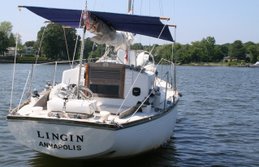WNR - Series II - Race 5Crew: Brian P., Scott, Mark and Glen
Competitors: 550, 247, 484
[Editor's (Tim's) note: Due to a late Wednesday work appointment, I was unable to make this race, so Glen graciously voluteered (or did I tell him he had to?) to skipper LinGin.]
Sweating in the stillness of the ride over, we started wondering if
there would be a race. The Etchells started 5 mins late, which both
gave us extra time and confused me. (I still don't have the decoder
ring that makes starting sequence signals clear, so if the sequence
gets out of whack all bets are off.) And to add to my green skipper
dilemmas, it was a spinnaker start. We decided on the old stand-by
tactic: follow Towney. As it turns out, in the barely-a-zephyr
breeze, I didn't even do that very well. Most of the fleet chose the
slightly-better downwind sailing angle of the pin end, while we ended
up on the boat end. And got lucky for it: the building breeze on that
leg reduced the advantage of a larger tacking angle downwind. Since
the AC course led us past R4 and the spider, we had a more direct line
to the first mark and were doing well. At R4 we had a 5-6 length
lead. Occasionally, it truly does pay to be lucky rather than good.
Just after passing R4, our new course and the slowly clocking breeze
required a jib hoist/spin douse. Building and clocking
simultaneously, the course to the F drop mark turned into a proper
windward leg. And build it did. With grey overcast skies the
embedded thunderstorm was invisible until the wind jumped and the
stinging rain hit at the same time. Just a wee bit overpowered, we
worked slowly through reefing the main. Afterward Scott alertly
repacked the chute in case the storm passed by the time we rounded F
and embarked on the newly-downwind leg.
Sailing delicately, my main goal being to not break anything, Argo
passed us and rounded first. Rounding the mark we did a
long-way-round tack rather than gibing in that wind. Towney was about
5 lengths behind rounding the mark. We were under reefed main and
full jib running almost dead downwind. We tried wing-and-wing for a
few minutes with some success. At this point I happened to look back
to see a distinct line on the water. I hollered for the jib to be
doused. It turned out to be merely
*harder* rain and not a gust.
(BTW, all this time we're sailing with no companionway hatch cover.
The temporary plywood very susceptible to the wind and us with no
spare hands to lash it down anyway. I wondered idly what Tim's
response would be to us sinking the boat with rain water.)
Other than Towney and a couple big boats ghosting through, we had no
visible references. Slowly the spider came into view and even abeam
the spider, Greenbury Point and the southern bank were obscured.
Scott, having been busy on deck dropping and securing the jib, had a
chance to look around, smiled, and asked, "Just for reference, where's
land?"
During this time, I have to say, was a very cool experience. With
limited visibility, high wind creating very uniform chop waves, heavy
rain giving the water a matte texture, and colder rain on warmer water
causing small bits of mist to form in the troughs, it was an unusual
sight. It's too bad we weren't carrying a submersible camera.
With the jib down and most things stable, we talked about our options.
I was not sure I wanted to sail the harbor in those conditions. We
decided to keep going that direction and hope the storm passed. We
got inside R4 again and, with no signs of clearing and the knowledge
that we'd have to pound back upwind in 25kts to round the spider to
get home, we decided it was time to abandon. We started the engine
and motor-sailed back under reefed main eating soggy sandwiches and
reveling in our choice of hobbies.
Except for the bummer of not finishing, it was a fun race. We didn't
get the boat too soggy, it was hot enough that rain didn't chill us,
and we got some exercise...both physical and mental. It's too bad Tim
wasn't there to see it with us and take us over the finish line, but
we had a blast none-the-less. As it turned out, only Skybird and Argo
finished so we ended up with 3 points and retained our lead for the
series.
Thanks to Mark, Brian, and Scott for doing all the hard work!
-Glen

